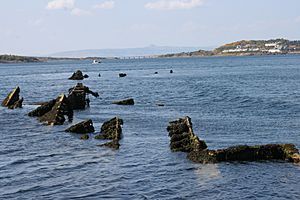HMS Port Napier facts for kids
class="infobox " style="float: right; clear: right; width: 315px; border-spacing: 2px; text-align: left; font-size: 90%;"
| colspan="2" style="text-align: center; font-size: 90%; line-height: 1.5em;" | 
|} HMS Port Napier (M32) was a special ship called a minelayer used by the British Royal Navy during World War II. Her job was to lay naval mines in the sea to protect areas or stop enemy ships. Sadly, on 27 November 1940, she was destroyed by a big explosion after a fire in her engine room. This happened in Loch Alsh, a sea loch in Scotland.
Contents
| History | |
|---|---|
| Name | HMS Port Napier |
| Builder | Swan Hunter and Wigham Richardson Ltd., Wallsend |
| Launched | 23 April 1940 |
| Commissioned | 12 June 1940 |
| Fate | Destroyed by explosion/engine room fire, 27 November 1940 |
| General characteristics | |
| Type | Minelayer |
| Tonnage | 9,600 GRT |
| Length | 498 ft (152 m) |
| Beam | 68 ft (21 m) |
| Armament |
|
The Story of HMS Port Napier
The Port Napier was not originally built to be a warship. She was being built as a cargo ship for a company called Port Line at the Swan Hunter shipyard in Wallsend. But during World War II, the Royal Navy needed more ships. So, they took over her construction and changed her into a minelayer.
Building a Warship
To make her ready for war, the ship was covered with thick armour plate, about 2-inch (51 mm) thick. Her cargo areas were changed to hold up to 600 naval mines. These mines are like underwater bombs. The ship also got weapons for defence. She had two 4-inch (100 mm) guns, two 40 mm (1.6 in) "2-pounder" guns, and four 20 mm guns. These smaller guns were mainly for shooting down enemy aircraft.
The Port Napier was finished and launched into the water on 23 April 1940. She officially joined the Royal Navy on 12 June 1940. She then became part of the 1st Minelaying Squadron, which was based in Kyle of Lochalsh in western Scotland.
A Dangerous Mission
On 26 November 1940, the Port Napier was getting ready for a mission. She was loaded with 550 mines. Each mine already had its detonator (the part that makes it explode) fitted. This made them very dangerous. The ship also carried lots of ammunition for her guns.
That evening, a very strong wind, called a gale, started to blow. The Port Napier's anchors could not hold her in place, and she began to drift. Her propellers got tangled in the anchor chains of another ship, a collier (a ship that carries coal). Both ships drifted into shallow water and got stuck on the seabed.
The Explosion
The next day, the other minelaying ships left for their mission. The Port Napier and the collier were separated. The Port Napier started to refuel, but then a fire suddenly broke out in her engine room.
Most of the crew had to leave the burning ship. But a small group of brave volunteers stayed behind. They tried to remove the detonators from the mines to make them safe. After doing what they could, they also had to leave the ship.
Because of the huge risk of the mines exploding, the Port Napier was towed out into the open loch. She was then left to drift. People living in the nearby village of Kyle were told to leave their homes for safety. All other ships left the port.
It looked like the fire was dying down, so another group of volunteers went back onto the ship. They found that the decks were extremely hot and bending out of shape. They managed to push some mines off the back of the ship, but the heat and danger forced them to leave again.
Soon after they got off the ship, two smaller explosions happened. Moments later, there was a massive explosion! This caused the Port Napier to flip over and sink. She came to rest on her side in about seventy feet of water.
Later, divers from the Royal Navy checked the wreck. They found that the front and back of the ship were mostly okay. But a 100-foot (30 m) section of her side had been completely blown out. The ship was considered a total loss.
In 1944, some steel plates from the wreck were removed to be used for other ships. However, the unexploded mines and ammunition were not taken out until 1950.
Today, the wreck of the Port Napier is a popular spot for scuba diving. It's still quite complete and lies in shallow water at 57°15′57.24″N 5°41′15.03″W / 57.2659000°N 5.6875083°W.

